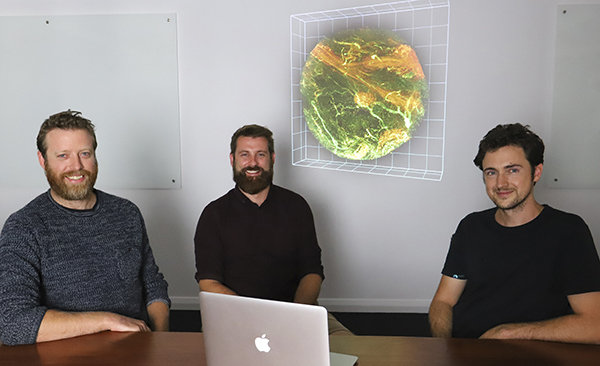Virtual cells provide new cancer insights
Academics from the University of Newcastle and the Hunter Medical Research Institute (HMRI*) have developed the world’s first virtual platform to host 3D copies of human cancer tissues, revolutionising the way researchers access critical information needed to advance cancer treatment.
The Virtual Biobank will digitise and help speed up the process of accessing vital tissue samples donated by patients, which up until now could only be requested through physical biobanks.
With cancer a leading cause of death in Australia, chief investigators Dr Jamie Flynn, Dr Antony Martin and Dr William Palmer developed The Virtual Biobank as an open resource to accelerate and enhance medical research activities.
“It currently takes many months before researchers are able to obtain tissue samples from a physical biobank and carry out investigations with it. Once a researcher has performed their study, that sample typically cannot be reused.
“Each digital cancer sample in The Virtual Biobank is made up of high resolution microscopy images in both 2D and 3D, plus important clinical and molecular information that provides the foundation for virtual research into cancer.
“We’ve taken a tiny sample from tumor biopsies stored at the Hunter Cancer Biobank** and converted them into a virtual copy, enabling anyone around the world with an internet connection to carry out research from their computers or easily request access to the physical sample they need.
“This process ensures the physical sample remains intact, but a 3D, digital copy with clinical and experimental information is kept online for future use. This is particularly critical for rare cancers, which are hard to study due to a limited number of samples,” Dr Flynn explained.

Research team behind the Virtual Biobank L-R: Dr William Palmer, Dr Jamie Flynn and Dr Antony Martin.
Online anatomical library
Working with the University of Newcastle’s Hunter Cancer Biobank based at HMRI, Dr Flynn and his colleagues have uploaded the first 20 breast cancer samples to The Virtual Biobank with accompanying clinical descriptions.
The addition of 3D images was made possible by the innovative 3D Tissue Clearing and Lightsheet Microscope Facility (established by the same team in 2016) based at HMRI, which specialises in making tissue samples ‘see through’ for cutting edge 3D microscopy.
Hunter Cancer Biobank Scientific Advisor, Dr Rick Thorne, said The Virtual Biobank is key to unlocking the third dimension of cancer tissues.
“Putting these samples in their true context for the first time will help researchers with many different problems, including how to get treatments to all of the cancer cells in tumors.
“The project has kicked off with breast cancer, but the processes used by the team are applicable to any cancer tissue. It is remarkable this will happen online and we look forward to future expansions of the dataset.”
Software behind the site
Working closely with colleagues across the University of Newcastle’s IT department and Library Research Services, the team embedded specialised software tools into the online platform that would otherwise be too expensive for researchers to access.
“We really wanted to make The Virtual Biobank interactive and dynamic, so with lead developer, Dr Bill Pascoe, and the Academic Research Computing Support team (ARCS), we developed a software toolkit for other people to contribute additional information such as findings from their own investigations,” Dr Martin said.
The ‘Tissue Tracker’ component of the site allows users to automatically log the experimental procedures for all new tissue samples coming into a lab, removing the need for hand-written notes and allowing other researchers to easily replicate experiments.
“Users can also create full 3D images for free by simply uploading their own microscopy data to our ‘Terastitcher Pipeline’, eliminating the need for expensive commercial software that can ordinarily cost upwards of $50,000,” Dr Martin said.
Opening up a world of discovery
While still in its early stages, the online platform holds promising future potential in areas of research, education and even virtual reality.
“The technology and tools that we’ve put together make this data available to anyone in the world. People in the fields of engineering or computer science can now easily apply their knowledge to questions surrounding cancer.
“Educators can also access the site and use real-world examples to teach pathology to the next generation of cancer clinicians and researchers.
“We’d also like to convert the 3D data into virtual reality for education and general awareness. Hopefully soon, anyone with a smartphone and Google Cardboard could experience the internal environment of cancer tissue and bring about new insights,” Dr Palmer said.
Established through funding provided by the Australian National Data Service, The Virtual Biobank aims to work with biobanks around the country to continue uploading a variety of cancer tissues onto the platform.
Donations to the project can be made via The Virtual Biobank website virtualbiobank.newcastle.edu.au
* HMRI is a partnership between the University of Newcastle, Hunter New England Health and the community.
**The Hunter Cancer Biobank was first established in 2012 as a joint initiative of Hunter Cancer Research Alliance, Pathology North (Hunter New England) and Hunter New England Local Health District. Collaborating clinicians from Calvary Mater Newcastle and Hunter New England Local Health District provide access to patients willing to donate specimens to the biobank.
Related news
- Shanae’s passion for caring delivers her dream to work in health
- Food and nutrition degree serves Keren a rewarding career
- Kicking goals on and off the field, Joeli proves you can do it all
- Proving age is just a number, Arlyn wants to inspire more women in their 50s to pursue education
- Earth Sciences expert Professor Frisia cements global standing
The University of Newcastle acknowledges the traditional custodians of the lands within our footprint areas: Awabakal, Darkinjung, Biripai, Worimi, Wonnarua, and Eora Nations. We also pay respect to the wisdom of our Elders past and present.